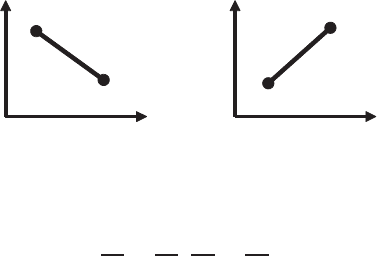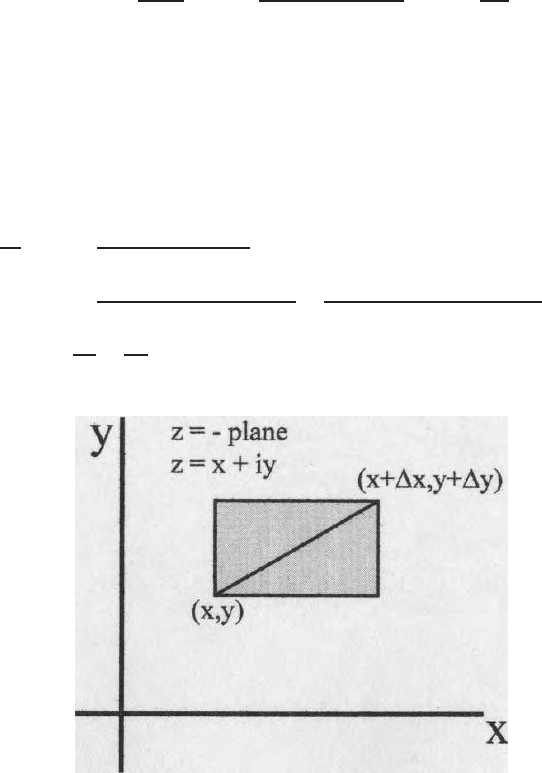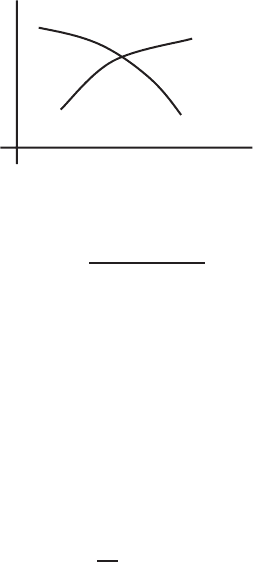Roy K.K. Potential theory in applied geophysics
Подождите немного. Документ загружается.


8.5 Geoelectrical Potentials for an Anisotropic Medium 259
J
x
= −
Cx
ρ
3/2
l
x
2
+y
2
+ λ
2
Z
2
3/2
(8.273)
J
y
= −
Cy
ρ
3/2
l
x
2
+y
2
+ λ
2
z
2
3/2
(8.274)
J
z
= −
Cz
ρ
3/2
l
x
2
+y
2
+ λ
2
z
2
3/2
(8.275)
such that
J=
J
2
x
+J
2
y
+J
2
z
1/2
= −
C
x
2
+y
2
+z
2
1/2
ρ
3/2
l
x
2
+y
2
+ λ
2
z
2
3/2
. (8.276)
In order to find the constant of integration C (8.276), we construct around
the point P, a sphere of radius R and calculate the total current flowing
out through this spherical surface. This is equal to the total current flowing
through the point P.
Thus
I=
s
J.ds =
2π
0
JR
2
sin θ dθ dψ.
Now
x
2
+y
2
=R
2
sin
2
θ
and
Z
2
=R
2
cos
2
θ
and (8.276) b ecomes
J=
C
ρ
3/2
l
R
2
sin
2
θ + λ
2
cos
2
θ
3/2
=
C
ρ
3/2
s
R
2
1+
λ
2
− 1
cos
2
θ
3/2
.
(8.277)
We can write
J=
Iλ
x
2
+y
2
+z
2
1/2
4π
x
2
+y
2
+ λ
2
z
2
3/2
=
Iλ
4πR
2
1+
λ
2
− 1
cos
2
θ
3/2
I=
C
ρ
3/2
l
2π
0
dψ
π
0
sin θdθ
1+
λ
2
− 1
cos
2
θ
3/2
(8.278)
=
2πC
ρ
3/2
l
.
2
λ
=
4πC
λρ
3/2
s
. (8.279)

260 8 Direct Current Field Related Potential Problems
Hence the expressions for the potentials and the current densities become
φ =
Iλρ
S
4π
x
2
+y
2
+ λ
2
z
2
1/2
=
Iρ
m
4πR
1+
λ
2
− 1
cos
2
θ
1/2
(8.280)
and
J=
Iλ
x
2
+y
2
+z
2
1/2
4π
x
2
+y
2
+ λ
2
z
2
3/2
=
Iλ
4πR
2
1+
λ
2
− 1
cos
2
θ
3/2
. (8.281)
8.5.2 General Solution of Laplace Equation for an Anisotropic
Earth
Equation (8.259) is the guiding equation for solving problems for an isotropic
earth. When resistivity of a medium varies along the longitudinal and traverse
direction, (8.259) changes to the form
1
ρ
1
∂
2
φ
∂x
2
+
∂
2
φ
∂y
2
+
1
ρ
t
∂
2
φ
∂z
2
=0. (8.282)
Applying the method of separation of variables φ = R(r)Z(z), we get
∂
2
R
∂r
2
+
1
r
dR
dr
− λ
2
R = 0 (8.283)
and
∂
2
Z
∂z
2
− m
2
λ
2
Z=0. (8.284)
Solving these two-equations (8.283) and (8.284) and substituting the values,
we get the expression for the perturbation potential as
φ =
∞
0
A(λ)e
−mλz
J
0
(λr) dλ +q. (8.285)
The source potential q, can be written for anisotropic earth as
q=
Iρ
m
2π
∞
0
e
−mλz
J
0
(λr) dλ (8.286)
using Weber Lipschitz identity where
ρ
m
=
√
ρ
t
ρ
l
.
For a two layer earth, potentials in the three regions following Wait (1982)
and Negi and Saraf (1989), we can write

8.5 Geoelectrical Potentials for an Anisotropic Medium 261
φ
0
=
Iρ
0
4πR
+
∞
0
A
0
(λ)e
λz
J
0
(λr) dλ (in the air) (8.287)
φ
1
=
∞
0
A
1
(λ)e
−m
1
λz
+B
1
(λ)e
mλz
J
0
(λr) dλ (in the first layer) (8.288)
and
φ
2
=
∞
0
A
2
(λ)e
−m
2
λz
J
0
(λr) dλ (in the lower half space) (8.289)
where
Iρ
0
4πR
is the source term
where
R=
r
2
+(z+z
0
)
2
, m
1
=
ρ
t1
/ρ
l1
(8.290)
and
m
2
=
ρ
t2
/ρ
l2
.
To evaluate A
0
, A
1
, B
1
, A
2
the boundary conditions are applied. The boundary
conditions are
(i) φ = φ
1
at z = 0
(ii) φ = φ
2
at z = h
(iii) J
0
=J
1
at z = 0
(iv) J
1
=J
2
at z = h
where J
0
, J
1
and J
2
are the current densities in the respective media. Here for
anisotropic earth
1
ρ
0
∂φ
0
∂z
=
1
ρ
t1
∂φ
1
∂z
at z = 0 and
1
ρ
t1
∂φ
1
∂z
=
1
ρ
t2
∂φ
2
∂z
at z = h
Using the four boundary conditions,
A
0
(λ) can be written as
A
0
(λ)=−
Iρ
0
4π
.e
−λz
0
ρ
0
− ρ
1n
(P
1
/P
2
)
ρ
0
+ ρ
1n
(P
1
/P
2
)
(8.291)
where
ρ
ln
=(ρ
l1
/ρ
t1
)
1/2
, ρ
2n
=(ρ
l2
/ρ
t2
)
1/2
P
1
=
1 −R
1
e
−2λh
1
, P
2
=
1+R
1
e
−2λh
1
where
m
1
h=h
1

262 8 Direct Current Field Related Potential Problems
and
R
1
=
ρ
1n
− ρ
2n
ρ
1n
+ ρ
2n
.
When the current source is at the air earth interface the potential in the first
medium
φ
0
=
Iρ
0
2π
∞
0
[1 + B
0
(λ)] e
−λz
J
0
(λr) dλ (8.292)
where
B
0
(λ)=−
4π
Iρ
0
A
0
(λ)=
2ρ
1n
(P
1
/P
2
)
ρ
0
+(P
1n
P
1
/P
2
)
− 1 (8.293)
ρ
0
>> ρ
1n
and ρ
2n
(8.292) reduces to
φ
0
=
Iρ
1n
2π
∞
0
1 −R
1
e
−2λh
1
1+R
1
e
−2λh
1
e
−hz
J
0
(λr) dλ. (8.294)
On the surface of the earth at z = 0
φ
0
(r
1
0) =
Iρ
1n
2πr
⎡
⎣
1 −2R
1
r
∞
0
e
−2λh
1
J
0
(λr)
1+Re
−2λh
1
dλ
⎤
⎦
. (8.295)

9
Complex Variables and Conformal
Transformation in Potential Theory
In this chapter, we have shown (i) how the complex variables can be used to
solve some problems in potential theory, (ii) how real and imaginary quan-
tities together can represent field lines and equip otential lines and satisfy
Laplace equation, (iii) how analytic function and Cauchy Rieman’s equations
in complex variables can be used for solving certain kind of two dimensional
problems. Schwarz Cristoffel method of conformal transformation can be used
for solving two dimensional geoelectrical problems. Three types of problems
are given where S-C transfor mations are used. These boundary value problems
are (i) where closed form solution is possible (ii) where closed form solution
is not possible and one has to use numerical methods and (iii) where closed
form solution is po ssible using elliptic integrals and elliptic functions. For the
benefit of the students a brief introduction on elliptic integrals and elliptic
functions are appended.
9.1 Definition of Analytic Function
If E is a certain point set in a complex plane (z = x + iy), if for every z, there
exists one or more complex number w, if a function of the complex variable z
with its value equal to w defined in E or briefly if w = f (z) and if z = x + iy
and w = u + iv, then we have u and v as functions of x and y (Fig. 9.1 a,b).
The function w is said to be continuous at a point z
0
=(x
0
+iy
0+
)ifu(x,
y) tends to u
0
(x
0
, y
0
) and v (x, y) tends to v
0
(x
0
, y
0
) when x tends to x
0
and
y tends to y
0
. Such a function is said to be analytic in a particular domain if
the differential coefficient of f (z) i.e.,
f
′
(z) = Lim
z→z
0
f(z) − f(z
0
)
z −z
0
(9.1)
exists for all paths joining z to z
0
. Th e necessary and sufficient conditions for
differentiability are

264 9 Complex Variables and Conformal Transformation in Poten tial Theory
z
=
- plane
z
=
x
+
iy
iy
x
o
z
z
0
w
=
- plane
w
=
u
+
iv
iv
u
o
Fig. 9.1 a,b. Complex Z and W plane; P oint by point mapping in the Z and W
plane
∂u
∂x
=
∂v
∂y
;
∂u
∂y
=
∂v
∂x
; (9.2)
and these partial derivatives are continuous. When these conditions are sat-
isfied f (z) is said to be analytic at the point z
0
.
9.2 Complex Functions and their Derivatives
We can define w to be a function of the complex variable z if for each value
of z, be longing to a prescribed set S, there will be co rresponding one or more
values of w. Such a definition proves to be too general to be particularly
useful for physical application. So we shall confine our attention to a much
more limited class of functions. Those which are single valued continuous and
possess a single class of function are generally chosen.
In defining the derivative of a complex function, we shall have to introduce
the concept of limit. Let f (z) be defined as single valued at all points in
the neighbourhood of z
0
except possibly at z
0
itself. Then we say that f (z)
approaches the limit w
0
. This is written as
Lim
z−z
0
→ f(z) = w
0
. (9.3)
If f (z) can be made arbitrarily close to w
0
then in the neighbourhood of
z
0
, z − z
0
is taken sufficiently small. Arithmatically this is expressed as fol-
lows: Corresponding to each preassigned positive numeric ε, no matter how
small, there exists a positive number δ such that |f (z) −w
0
| < εwhenever0 <
|z −z
0
| <δ,whereδ is infinitesimally small. For a function to be continuous
at a point i.e., for f (z) to be continuous at z
0
, the basic requirement is f (z
0
)
must exist at z
0
i.e,
Lim
z−z
0
→ f(z) = f(z
0
).
This definition is also valid where z
0
lies on the boundary of a closed region.
Let us put
w=f(z)=u(x, y) + iν(x, y). (9.4)
Two complex numbers are equal if and only if their real and imaginary parts
are separately equal,

9.2 Complex Functions and their Deriv atives 265
we get
Lim
x→0
y→0
u(x, y) = u(x
0
, y
0
) (9.5)
Lim
x→0
y→0
v (x, y)=v (x
0
,y
0
) (9.6)
and their path of movements lie entirely within the region of definition.
The derivative of f (z) with respect to z is given by
f
′
(z)=
df (z)
dz
= Lim
∆z→0
f(z + dz) −f (z)
∆z
= Lim
∆z→0
∆f
∆z
. (9.7)
Since ∆z = ∆x + i∆y, we see that there are an infinite number of paths
in the z plane along which ∆z can approach zero. A unique value of the
derivative regardless of the mode of approach, a set of necessary con d itions for
the existence of a unique derivative at a point is obtained (Fig. 9.2). Certainly
if the value of the limit obtained by first setting ∆y = 0 and then permitting
∆x to approach zero, the derivative is not independent of the path. If we first
put ∆x = 0, (9.7) becomes
df
dz
=Lim
∆y→0
f(z+i∆y)− f(z)
i∆y
(9.8)
= Li m
∆y→0
u (x, y +∆y) − u (x, y)
i∆y
+
i [v (x, y +∆y) −v (x, y)]
i∆y
(9.9)
= −i
∂u
∂y
+
∂v
∂y
. (9.10)
Fig. 9.2. Movements in the z-plane for determining the derivatives (Cauchy
Reimann Condition)

266 9 Complex Variables and Conformal Transformation in Poten tial Theory
Similarly, putting ∆y → 0 and taking the limit
df
dz
=Lim
∆x→0
f(z+∆x, y) − f(z)
i∆x
(9.11)
⇒ Lim
∆x→0
u (x +∆x, y) − u (x, y)
∆x
+
i [v (x +∆x, y) − v (x, y)]
∆x
(9.12)
=
∂u
∂x
+ i
∂v
∂x
.
These two expressions for the derivatives are equal if and only if
∂u
∂x
=
∂v
∂y
;
∂u
∂y
= −
∂v
∂x
(9.13)
⇒
df
dz
=
∂u
∂x
+ i
∂v
∂x
=
∂v
∂y
− i
∂u
∂y
=
∂u
∂x
− i
∂u
∂y
=
∂ν
∂y
+ i
∂v
∂x
. (9.14)
These pairs of first order differential equations are Cauchy-Riemann equations.
A function f (z) of complex variable z is said to be analytic at the point
z
0
, if it is single valued and possesses a derivative not only at z
0
but at every
point in a neighbourhood of z
0
. Otherwise the point z
0
is a singular point of
the analytic function. If f (z) is analytic at every point of a domain D, then,
differentiating the first equation with r espect to x and second equation with
respect to y, we have,
∂
2
ν
∂x
2
=
∂
2
ν
∂x∂y
and
∂
2
v
∂y
2
= −
∂
2
v
∂x∂y
.
Therefore
∂
2
ν
∂x
2
+
∂
2
ν
∂y
2
=0. (9.15)
Similarly, we get
∂
2
u
∂x
2
+
∂
2
u
∂y
2
=0. (9.16)
Both the real and imaginary parts of a complex functions are analytic func-
tions, and they satisfy Laplace equation in two dimensions.
ν(x, y) = C
1
is a family of curves where C
1
is constant.
m
1
=
∂y
∂x
=+(∂u/∂x) / (∂u/∂y) (9.17)
m
1
=
∂y
∂x
=+(∂u/∂x) / (∂u/∂y) . (9.18)
Similarly u(x, y) = C
2
,whereC
2
is another constant
.m
2
=
∂y
∂x
=+(∂ν/∂x) / (∂ν/∂y) . (9.19)
Now taking the products of m
1
and m
2
,wehave

9.3 Conformal Mapping 267
x
y
v(x,y)
=
β
1
u(x,y)
=
α
1
Fig. 9.3. Orthogonal propert y of u and v functions
m
1.
m
2
=
∂u/∂x.∂ν/∂x
∂u/∂y.∂ν/∂y
= −1. (9.20)
These two sets of tangents are orthogonal (Fig. 9.3). Therefore, if u (x, y) are
the equipotential lines then ν, (x, y) will be the field lines. Thus it is proved
that if u and v are analytic functions in a complex plane then they satisfy
Laplace equation and the slopes of the tangents are mutually orthogonal.
Hence u and v can be used to denote equipotential and field lines.
9.3 Conformal Mapping
Equations (9.14) are normally known as Cauchy Riemann equations. Geomet-
rical interpretation of derivative
dw
dz
= |f
′
(z)| is a measure of elongation of
an element in the z-plane when it is tra nsferred to w-plane. Arg {f
′
(z)} is
interpreted as rotation of an element dz with resp ect to an element dw. Arg
stands for argument in a complex quantity. It is represented in the form of an
angle similar to phase angles in an electromagnetics .
If we draw two curves through a point z
0
in the z plane and draw two
tangents at z
0
and map the two curves in the w plane by a function w = f(z)
which is analytic in a region such that f
′
(z) does not vanish (since otherwise
the mapping will not be one to one) and draw a tangent to each of the curves at
the point of intersection, the angle between the two tangents remain invariant
under mapping. This property of mapping is called conformal mapping in the
domain of analyticity (Fig. 9.4 a ,b). If the sense of angle is preserved together
with its magnitude, it is called conformal mapping of the first kind and if the
sense is preserved keeping its magnitude constant, it is called the co n formal
mapping of the second kind.
A complex potential, which is an analytic function, must have a singularity
at infinity otherwise it will reduce to a constant. Physical interpretation of
the singularity can be given. By definition, the singularities are points where
a function ceases to be analytic. Such points are precisely the points where
physical sources which give rise to potentials are located. Singular points in
a complex plane may b e poles, zeros, essential singularities or branch points
Spiegel (1964).

268 9 Complex Variables and Conformal Transformation in Poten tial Theory
x
iy
z = - plane
z = x + iy
z
c
B
u
iv
w = - plane
w = u + iv
A
c
B
Fig. 9.4 a,b. Show the movement of a point in the Z plane and the corresponding
movement in the W plane where the angle of movement is preserved
The mapping is said to be one to one over the finite domain of the z-plane
if there exists an inverse transformation function z = f
−1
(w) which will map
the w-plane onto the z-plane. Let w(z) = u(x, y) + iν(x, y). We can find the
values at x and y if the Jacobians is non zero.
i.e.
J
u, ν
x, y
=
∂u
∂x
,
∂u
∂y
∂ν
∂x
,
∂ν
∂y
=0. (9.21)
On making use of the Cauchy Riemann conditions into the (9.20), the Jacobian
can be shown to be
J
u, ν
x, y
= |f
′
(z)|
2
. (9.22)
This means that inverse transformation function exists if f
′
(z) =0.
Now assuming that an inverse transformation function exists and can be
found, let us take the transformation of a complex potential function.
Let φ (z) be a complex potential in the z-plane
φ(z) = U(x, y) + iV(x, y). (9.23)
We shall replace z by w u sing inverse mapping function
φ
f
−1
(w)
=U(u, v) + iV (u, ν) . (9.24)
It can be shown that U(u, ν)andV(u, ν) satisfy Laplace equation.
We know
∂
2
∂x
2
+
∂
2
∂y
2
=
∂
∂x
+i
∂
∂y
∂
∂x
− i
∂
∂y
. (9.25)
Now
∂
∂x
=
∂u
∂x
∂
∂u
+
∂ν
∂x
∂
∂u
(9.26)
and
i
∂
∂y
=i
∂u
∂y
∂
∂u
+i
∂ν
∂y
∂
∂ν
. (9.27)
